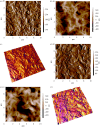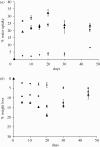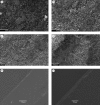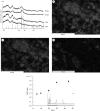Effect of nanoparticulate bioactive glass particles on bioactivity and cytocompatibility of poly(3-hydroxybutyrate) composites
- PMID: 19640877
- PMCID: PMC2842795
- DOI: 10.1098/rsif.2009.0255
Effect of nanoparticulate bioactive glass particles on bioactivity and cytocompatibility of poly(3-hydroxybutyrate) composites
Abstract
This work investigated the effect of adding nanoparticulate (29 nm) bioactive glass particles on the bioactivity, degradation and in vitro cytocompatibility of poly(3-hydroxybutyrate) (P(3HB)) composites/nano-sized bioactive glass (n-BG). Two different concentrations (10 and 20 wt %) of nanoscale bioactive glass particles of 45S5 Bioglass composition were used to prepare composite films. Several techniques (Raman spectroscopy, scanning electron microscopy, atomic force microscopy, energy dispersive X-ray) were used to monitor their surface and bioreactivity over a 45-day period of immersion in simulated body fluid (SBF). All results suggested the P(3HB)/n-BG composites to be highly bioactive, confirmed by the formation of hydroxyapatite on material surfaces upon immersion in SBF. The weight loss and water uptake were found to increase on increasing bioactive glass content. Cytocompatibility study (cell proliferation, cell attachment, alkaline phosphatase activity and osteocalcin production) using human MG-63 osteoblast-like cells in osteogenic and non-osteogenic medium showed that the composite substrates are suitable for cell attachment, proliferation and differentiation.
Figures








Similar articles
-
Comparison of nanoscale and microscale bioactive glass on the properties of P(3HB)/Bioglass composites.Biomaterials. 2008 Apr;29(12):1750-61. doi: 10.1016/j.biomaterials.2007.12.040. Epub 2008 Feb 6. Biomaterials. 2008. PMID: 18255139
-
Characterization of carbon nanotube (MWCNT) containing P(3HB)/bioactive glass composites for tissue engineering applications.Acta Biomater. 2010 Mar;6(3):735-42. doi: 10.1016/j.actbio.2009.09.023. Epub 2009 Oct 1. Acta Biomater. 2010. PMID: 19800427
-
In vitro biocompatibility of 45S5 Bioglass-derived glass-ceramic scaffolds coated with poly(3-hydroxybutyrate).J Tissue Eng Regen Med. 2009 Feb;3(2):139-48. doi: 10.1002/term.150. J Tissue Eng Regen Med. 2009. PMID: 19170250
-
Composite bone cements loaded with a bioactive and ferrimagnetic glass-ceramic: Leaching, bioactivity and cytocompatibility.Mater Sci Eng C Mater Biol Appl. 2015 Aug;53:95-103. doi: 10.1016/j.msec.2015.03.039. Epub 2015 Mar 24. Mater Sci Eng C Mater Biol Appl. 2015. PMID: 26042695 Review.
-
Poly(3-hydroxybutyrate): Promising biomaterial for bone tissue engineering.Acta Pharm. 2020 Mar 1;70(1):1-15. doi: 10.2478/acph-2020-0007. Acta Pharm. 2020. PMID: 31677369 Review.
Cited by
-
Bioactivity and Physico-Chemical Properties of Dental Composites Functionalized with Nano- vs. Micro-Sized Bioactive Glass.J Clin Med. 2020 Mar 12;9(3):772. doi: 10.3390/jcm9030772. J Clin Med. 2020. PMID: 32178372 Free PMC article.
-
Scaffolds Based on Poly(3-Hydroxybutyrate) and Its Copolymers for Bone Tissue Engineering (Review).Sovrem Tekhnologii Med. 2022;14(5):78-90. doi: 10.17691/stm2022.14.5.07. Epub 2022 Sep 29. Sovrem Tekhnologii Med. 2022. PMID: 37181830 Free PMC article. Review.
-
Effect of nano-sized bioactive glass particles on the angiogenic properties of collagen based composites.J Mater Sci Mater Med. 2013 May;24(5):1261-9. doi: 10.1007/s10856-013-4892-7. Epub 2013 Feb 22. J Mater Sci Mater Med. 2013. PMID: 23430337
-
Scaffolds for Dentin-Pulp Complex Regeneration.Medicina (Kaunas). 2023 Dec 20;60(1):7. doi: 10.3390/medicina60010007. Medicina (Kaunas). 2023. PMID: 38276040 Free PMC article. Review.
-
Triple-helical collagen hydrogels via covalent aromatic functionalization with 1,3-Phenylenediacetic acid.J Mater Chem B. 2013 Oct 28;1(40):5478-5488. doi: 10.1039/C3TB20218F. J Mater Chem B. 2013. PMID: 27390619 Free PMC article.
References
-
- Barrere F., Mahmood T. A., de Groot K., van Blitterswijk C. A. 2008. Advanced biomaterials for skeletal tissue regeneration: instructive and smart functions. Mater. Sci. Eng. R 59, 38–71. (10.1016/j.mser.2007.12.001) - DOI
Publication types
MeSH terms
Substances
LinkOut - more resources
Full Text Sources

